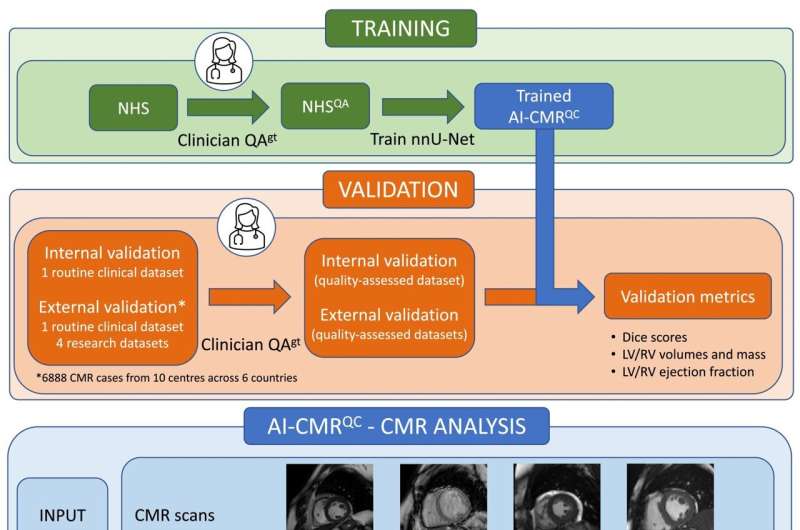AI-based, quality-controlled CMR analysis tool. The proposed CMR analysis tool consists of CMR image pre-processing steps, an AI method that automatically selects the cine acquisitions prior to image analysis, an AI method that segments the ventricles and the myocardium from short-axis cine CMR stacks, and a post-analysis QC step. QAgt, ground truth segmentation data quality assessment; QC, quality control. Credit: European Heart Journal - Digital Health (2023). DOI: 10.1093/ehjdh/ztad044
Many hospitals maintain their own large cardiac magnetic resonance (CMR) databases which, when combined with electronic health records, could provide valuable insights into the effectiveness of treatments and inform future health care research and guidelines.
However, databases are often organized differently by separate organizations and may often contain missing or duplicated files, which presents a significant challenge for processing data.
This work would previously have required a significant time investment for manual curation and analysis on the part of health care specialists, whereas an AI tool can be taught to efficiently "data wrangle" at large-scale, rapidly assess quality, and translate data into common formats and structures.
Researchers at the School of Biomedical Engineering & Imaging Sciences have trained a generalizable AI algorithm on data comprising more than 7,000 CMR scans, with initial results yielding human-level accuracy for left ventricle and right ventricle segmentations across all major CMR scanner technologies, and for a wide range of cardiac diseases.
This research was first published in a paper for the European Heart Journal—Digital Health.
"The proposed framework is a fundamental step for the clinical translation of AI algorithms. In addition, it allows for retrospective analysis of large clinical (research) datasets and compared to other works it allows analysis of a much larger set of biomarkers for regional and global systolic and diastolic biventricular function from CMR scans," says Dr. Esther Puyol.
"This work addresses the under-exploitation of the large clinical CMR imaging databases that many hospitals worldwide maintain. These are incredibly rich resources, containing historical and longitudinal data from many thousands of patients. When combined with data from electronic health records they could provide valuable insight into the effectiveness of treatments to inform future guidelines," says Dr. Andrew King.
Future work will seek to extend this framework towards obtaining biomarkers linked to systolic and diastolic function and their potential connections to patient treatments and health care outcomes.
More information: Jorge Mariscal-Harana et al, An artificial intelligence tool for automated analysis of large-scale unstructured clinical cine cardiac magnetic resonance databases, European Heart Journal—Digital Health (2023). DOI: 10.1093/ehjdh/ztad044
Provided by King's College London
























